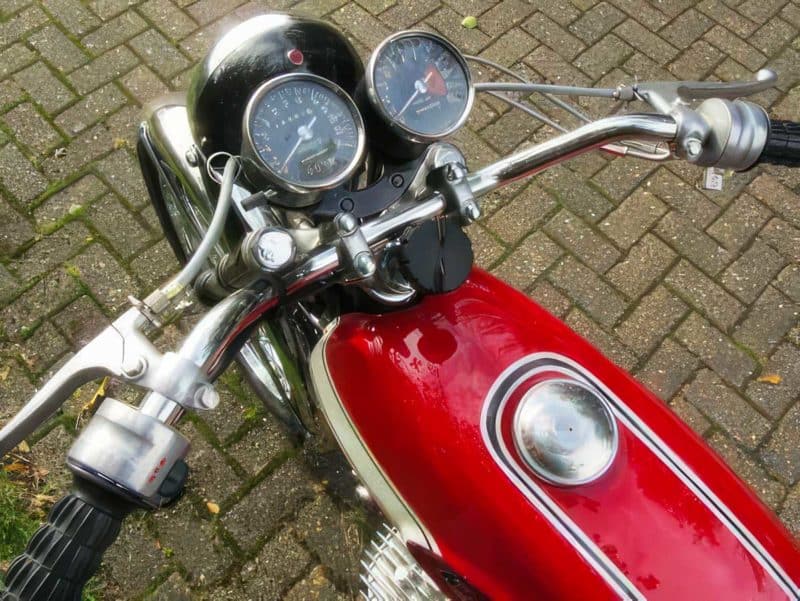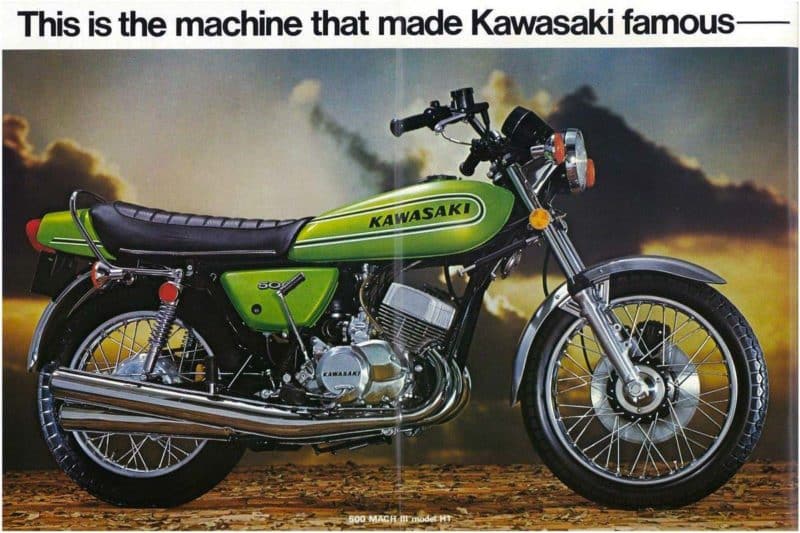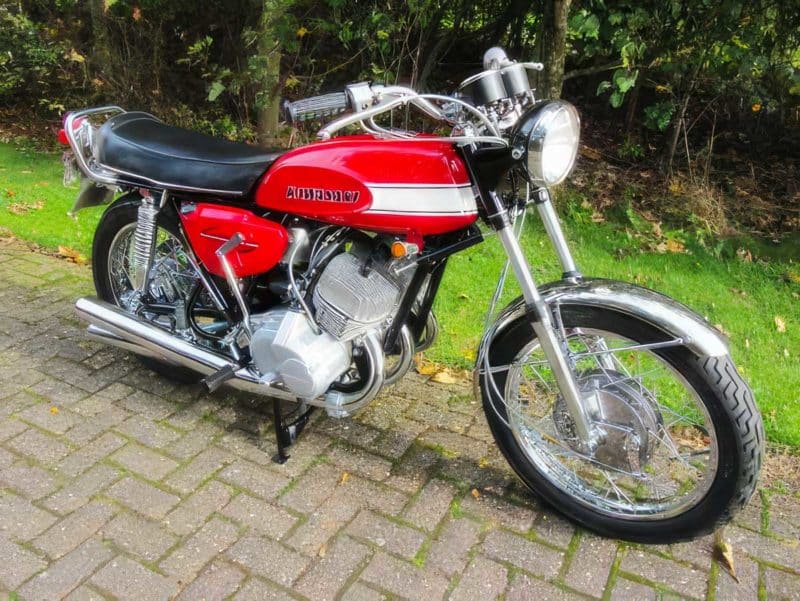'Widowmaker' or 'rodeo bike'. The revolutionary Kawasaki H1-500 cc three-cylinder got those nicknames for a reason. During their short life the machines have become less explosive, but they have never become fine touring models. That was not the intention of Kawasaki.
Kawasaki has chosen "power and speed" to be better than its competitors.
Kawasaki H1-500
The Kawasaki H1-500, the first of the legendary 3-cylinders, came out in 1969 and shocked the motorcycle world with its enormous performance. Kawasaki required the 500cc machine to make at least 60 horsepower and be able to complete the standing start quarter mile in under 13 seconds. The 'required' maximum of almost 200 km/h with a 500 cc two-stroke was unheard of.
These machines were soon nicknamed widowmaker or rodeo bike due to the ferocious power and poor quality of the bicycle part. And what is now called 'wheely' was then called 'climbing the chain'. A lagging bicycle section was a Japanese trend at the time. The engine blocks were 'too fast' for the bicycle parts.
The Kawasaki H1-500 had some limitations
With the Kawasaki, the pain was mainly in the poor rear suspension and damping, and the use of nylon bushings in the rear fork. Those buses were often worn out within a few hundred brave kilometers. With a pair of Koni's and bronze bushings, the Kawasaki H1 was already a lot better to ride, although the frame was no miracle of torsional rigidity either.
They became more civilized. Slightly more civilized
The savage features of the later models were refined and these are wonderful machines to drive on, while retaining the character of these two-stroke models. But it never became real competitors for the then current line of BMW boxers.
The Kawasaki H1-500 now and then
Over time, such an impressive motorcycle of the past has become a small, elegant motorcycle. The lines run almost like in a Chinese brush drawing. The heart of the machine? That is emphatically the air-cooled three-cylinder that, running at idle, sounds like three angry two-stroke dirt bikes muttering to themselves.
The Dutch Kawasaki importer Henk Vink already used the machine in March 1969 in the sprints in Uden. There he won the standard class up to 500 cc on a motorcycle with lights and (dealer) registration, but he just fell short of the 13 seconds that was the factory guideline. Henk Vink was therefore modeled differently than an undersized Japanese test driver. But Vink set the second fastest time of the day.
Only 1000 cc was faster
Jan Maas was the only one in the 'Specials above 650 cc' class who was faster with his 1000 cc JAP. It wasn't an issue on the sprint strip. But 'in the wild' the Kawasaki H1 was very thirsty. The fuel consumption was on average about 1 in 10 and with a fuel tank of 15 liters capacity, it often had to be refueled. Those who really had an overactive right hand could even halve the range. The H1-500 Mach III was the first standard engine with electronic ignition.
And there the law of the braking lead applied again: in Germany the model did not receive type approval because the electronic ignition caused interference with the television signal. With the current range of TV programs that would be a blessing.
Scarce and wanted
At the moment these Kawasakis are scarce and sought after. They are scarce because there are an above-average number of crashes on public roads or on circuits. They are sought after because they are the most spectacular examples of the short period when fast, heavy two-strokes were 'hot'. In the Netherlands, on Texel, the company of the Smitbros is an international place of pilgrimage for Kawa fans. The company is run by Hans and Alfons Smit, two very fanatical enthusiasts of engines and technology. I once bought a Kawasaki H1 with a Robinson brake with eight ascending shoes and expansion exhausts for 800 guilders. That was not top. Now think of amounts up to 17.000-20.000 euros for a top copy.
Specifications
3-cyl. 2T air-cooled, thyristor ignition, bore x stroke: 60×58,5; 498cc; 3x Mikuni 28mm; 60 hp/7500 rpm.; 5 gears; double cradle frame, wheels: front; 3.25×19, rear; 4.0×18, tank capacity 15 l; 195 km/h.







The one thing that will stay with me all my life was that in 1971 my friend had a serious accident with a Kawasaki H1-500 he had just bought and was disabled all his life. Some boys, in the Utrecht area, also called these motorcycles killers, because they were so fast and we were not used to that at the time and often drove too fast without recognizing the dangers.
the last photo
Just one more photo
Had a lot of fun, drove 50000 kilometers, it was a dangerous thing, owned for 2 years. Smoothly. Still have a folder left of it, see below.
No doubt they will be good these days. We used to call them "Kwaia". Says enough. And usually the "widowmakers" are in waves or BMWs, fortunately not on the motorcycle, because it doesn't say that, a cap with a helmet over it 🤪🤣
Somewhere in the early 80s I bought one without registration for 100 guilders, completely complete. The ignition turned out to be broken and the relevant module, which was sealed with resin, cost 800 guilders at Gaartman in Apeldoorn. Opened the cabinet and it turned out to be a print with 5 parts. Counterfeiting cost 5 guilders and then it ran again. Due to circumstances it remained for years after which I sold it without license plate for 800 guilders. Dolf previously also wrote about a 500 that he had bought for 800 guilders, coincidentally, but that turned out not to have been mine.
I can still remember that article in 'Motor', in which the disbelief about the performance was expressed in the possible 'breaking' of the block.
Something along the lines of: “can this stay intact – it has to, because Kawasaki would….etc.”
I have only read about these two-strokes, not driven a meter with them.
And the need to change that, well no, I do read the stories. Kawasaki's real breakthrough came in my opinion with the Z1, which immediately became a benchmark for high-performance 4-stroke 4-cylinders
A Suzuki GT750 also drank like a kind of punctured barrel. At least that's how I remember the lamentation of a former schoolmate. He then had one and complained strongly about the strong thirst of his 'water buffalo'. What he didn't complain about was his performance 😜 When he drove away from school, that thing resembled a 'moving chip shop'. That's how that thing smoked. Pire nostalgia and it remains beautiful!
I've owned and driven just about every model from that time.
Samurai, Avenger, several Mach III/H1's and an H2.
Also spent some time running around on a 500 racer with an 8 shoe Cerhan McKay and expansion pipes. Very exciting on the public road…
This 500 may be thirsty, in 1979 my brother drove Suzuki GT500 (just got his driver's license there then) and I rode Yamaha XS500.
Clear difference between the two-stroke and four-stroke in refueling. He had to fill up twice and I only had to fill up once. Tank contents didn't differ that much so I think I was well on my way to that Kawa vwb through his throat!